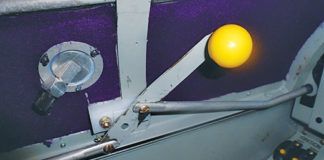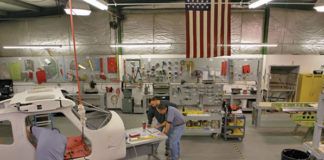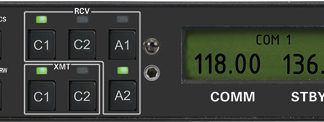So, Rick,” he said. “Would you do it again? The same way?” My flying buddy Ace Rodriguez had just posed a very interesting question as we nursed our Long Islands over a spectacular steak dinner in North Platte, Nebraska, returning from Oshkosh. Answering that question accurately was going to take a fair amount of reflection.
With the submission of the sixth (and originally intended to be final) article in this multi-part Zodiac 601 XL build series, I thought I was done. However, there were still some loose ends to the whole story nagging me, and the powers that be at the KITPLANES® editorial office agreed that another “last” segment might make interesting reading. [Just like the building process itself, you’re never quite done even when you think you are.—Ed.]
The saga of getting the airplane to California from Florida was certainly worth mentioning, as was the answer to Ace’s question. So here is the final (I promise) chapter. Really.
Wanted: A Change of Longitude
One of the more obvious challenges in building an airplane in Florida while living near San Francisco is the ultimate reunion of the aircraft owner and the airplane. There are only two choices, really. Either I move to Florida, or the airplane comes out to California.
The second choice was the most reasonable one, so I then contemplated making yet another East to West coast cross-country flight in a small, relatively slow airplane. I had just done this very thing in 2005 in a Varga Kachina, with my 17-year-old daughter, Amelia, in the back seat. She divided her time between flying and serving as the in-flight entertainment director with her eclectic selection of CDs. As enjoyable as this whole 33-flight-hour experience was, I was in no rush to do it again so soon.
Meet This Guy Named Woody…
While attending last fall’s open house at Quality Sportplanes in Cloverdale, California, I made the acquaintance of Woody Harris, who was also building a Corvair-powered Zodiac in nearby Vacaville. A self-described “lifelong gearhead,” Harris had spent his adult life in the motor racing business, currently heading up a specialty shop that builds racing motors.
Better still, Harris was a fairly new Private pilot who was itching mightily to add some Zodiac 601 stick time to his logbook, and he floated the concept of his going back to Edgewater to bring my 601 home. Recalling the dismal groundspeeds from westerly headwinds—and my aching rear end from the Varga’s non-adjustable seat designed for someone much shorter than me—I thought he seemed the perfect victim…er…candidate for such an adventure.
Upon further discussion, I was pleased to find out how well thought out his plan was. (Besides the going completely cross-country in a 100-knot Light Sport Aircraft part.) He planned on taking his daughter Amy Choi along, who’s an Embry-Riddle graduate with CFII and MEI ratings. Her expertise, for sure, would make up for any lack of real-world aeronautical experience her dad might be lacking.
So, after a call to Jim Nelson at Falcon Insurance, Harris would be legal and insured to fly as PIC of N42KP after a minimum 1-hour checkout by a CFI in the same model airplane. Of course, my premium would go up by over a third, but it still seemed much better than my taking yet another week away from my neglected business after the weeks spent in the construction of my Zodiac.
Having experienced the unplanned diversions, delays and dilemmas of low-performance, cross-country VFR flight many times, I still couldn’t resist asking how long Harris thought this flight might take. “Oh, we’re figuring about three days,” he said. “We figure we’ll make about 800 miles a day.”
It sounded a trifle optimistic at the time, and as it turned out, it was.
May 24, 2007
After arriving in Daytona the day before via commercial flight, our father-daughter Zodiac relocation team planned on flying with Gus Warren to gain quick intimacy with 42KP’s flight characteristics and (admittedly) non-conventional instrumentation. However, the spring weather in Florida had a mind of its own. “We were awakened around midnight by intense lightning and thunder,” Choi recalls.
The local weather never did improve quite enough to allow for a full day of flying, with 20-plus-knot winds directly across Massey Ranch’s single runway, but Harris had logged a few hours of Zodiac dual at California’s Rancho Tehama Airport before going to Florida. So at least he was properly insured in my airplane, technically.
The decision was made that all flying would have to wait until the following day, when the weather was forecast to improve and the crew would launch for the first leg westward. “I really wasn’t worried about it,” Choi says. “After all, we’re talking about my dad here.”
Departure Day: May 25, 2007
Although the ramp was still wet, the improving weather gave the crew great hope for the first day’s flight homeward. The departure from Massey Airpark was uneventful, and “the weather was actually pretty good,” according to Harris. “Until we got into all of the smoke from the forest fires in Georgia,” Choi added.
The first planned fuel stop was Defuniak Springs (54J), in Florida’s panhandle some 292 miles away. It was on that first leg that the crew began to experience the reality of a long cross-country in a light airplane. “It started getting really bumpy in the afternoon,” says Harris, “and it was really taking a toll on our bladders.” With an empty weight of just over 800 pounds and light wing loading, turbulence penetration just isn’t what Chris Heintz had in mind when he designed the 601. “We had a discussion about who was going to make that landing and taxi in,” recalls Choi, “so the other could be the first to race to the bathroom.”
Upon disembarking from the aircraft and setting a direct course for the loo, the crew was intercepted by the FBO manager, who apologized for the fuel pumps being out of service. “That’s OK, we have a little fuel left,” Harris said, “but what we really need now is your restrooms.”
After addressing the immediate physiological needs, Harris and Choi saddled up again for the short 19-mile flight to Crestview (CEW), where 100LL was available from operational pumps. “This is what really slowed down our progress,” says Harris. “We hadn’t figured how long it takes to set up an approach, land, taxi in, refuel and all the rest before flying again.”
Another part of the delays had to do with folks asking about the airplane. “The people who have been reading about it in KITPLANES® had a lot of interest in it,” Harris said, “especially the Corvair powerplant. We didn’t want to shortchange them, so we inevitably opened up the cowl so they could take a look.” This kind of delay never figures into the initial preflight planning.
Climbing up to 6500 feet, they bumped along for a couple of hours to Brookhaven, Mississippi (1R7), for a rest overnight before continuing their journey. “We were kind of disappointed to have only made 518 miles the first day,” recalls Choi. “Little did we know that the first day would be one of the best of the entire trip.”
Time to Spare? Go by Air
One thing that became apparent during that first day was the need to make some seating adjustments to the Zodiac’s fixed, semi-reclining seats. Harris and Choi both needed a bit more elevation for a better view over the panel, and a second cushion to move them forward, so a quick trip to the local Wal-Mart via crew car was in order. A couple of boat cushions and kiddy kickboards did the trick. (“We got gender-specific ones,” says Choi. “Cars for Dad, Little Mermaid for me.”)
The initial departure plan from Brookhaven called for a “dawn patrol” liftoff, but as is so often the case, the actual local departure time was somewhere around 11 a.m. Climbout and cruise were uneventful with smooth air and good visibility until roughly 70 miles into the leg, when the I-K engine monitor’s high-EGT temperature limit was reached and the red LED at the top of the scale glowed brightly.
There was no other indication of an excessive EGT problem, as all of the other engine parameters were reading normal. But a red light demands attention, and the decision was made to immediately find the nearest airport to investigate the malady. Concordia Parish (0R4) was the closest one, but 15 miles behind. Even so, a quick 180 was made and Concordia became the newest destination.
The residential airpark was largely unattended, but a fellow EAAer (who was in his hangar working on his own project) quickly arrived in his pickup, offering tools and assistance should they be needed. The trouble was soon traced to a pair of EGT probe wires that had worked loose from the I-K’s CPU box, and they were reinserted and tightened.
On the Route Again
Back aloft, the air was getting steadily rougher, and a nasty-looking front was looming directly ahead, so Angelina County Airport (LFK) in Lufkin, Texas, became the next unplanned stopover. “That was the furthest we could make it,” Choi said. “No kidding,” Harris added. “We had to fly under this big, black shelf to make it that far, and by the time the burgers came off of the grill, it was coming down in torrents.”
Finding overnight lodging was a challenge, as nearly every room was booked to accommodate the out-of-town attendees of a local horse auction. But after much calling around, a single room was reserved. “We got up again at o’dark thirty,” Harris said, “but we couldn’t really get out of there until close to 11 due to mist and fog.” A line of embedded thunderstorms was blocking the way further west, but the forecast also called for clear below 12,000 locally. The desire to put some miles behind was pressing hard.
“We took off out of Lufkin, headed for Brady,” recalls Choi, “and pretty soon we’re on top of this layer that’s getting thicker and thicker. The holes underneath are getting smaller and smaller, so I pull out this Commercial maneuver that I thought I’d never use, a 60° descending spiral.” It was at this moment that the Blue Mountain G4 became really confused, and actually indicated that the airplane was inverted.
Small World, Ain’t It?
Below the layer, Huntsville, Texas, (UTS) was the next airport of opportunity, so a landing was made to check the weather updates. “The briefer actually said, ‘Well, y’all better get comfortable, ’cause you ain’t going nowhere for a while,’” Choi recalled. Further confirmation of the nasty conditions to the west came from none other than one of Harris’s cousins, who was bringing a huge Evergreen Aviation Sikorsky Sky Crane east to fight the fires in Georgia. Cousin Terry and his crew had just flown in from Brady, scud-running the entire way.
With water pouring down, father and daughter once again decided to go shopping at a local Wal-Mart, and “check out the finer Huntsville laundromats” to address a growing collection of dirty clothes. “It wasn’t even noon yet,” Harris said, “and here we are stuck for the night.” Total miles logged for the day: 51.
The following day was almost a carbon copy of the preceding one, with the forecast just encouraging enough to launch, but the actual conditions falling somewhat short for extended VFR flight. “We flew the last 12 miles of the day at pattern altitude,” recalls Choi, “and all of my Instrument ratings were pretty much useless that day.” Once again, the crew made it as far west as they could, a whole 41 miles to Easterwood Field (CLL) in College Station, Texas.
Ever the optimists, Harris and Choi thought that they could make San Angelo, Texas, the next day with a little cooperation from the weather. Sure enough, the day dawned bright but hot and humid, even at cruise altitudes. “When we left Florida,” Harris recalls, “we thought that we’d end up cruising at 8500 for most of the trip. And we would’ve, if we had those same conditions.” After another uneventful departure, Curtis Field (BBD) in Brady, Texas, was reached without difficulty, 157 miles from College Station.
That’s It, Dad. I’ve Had Enough
“We didn’t really consider how hot, humid and bumpy it could get over West Texas,” Choi said. “And there were times when getting to 6500 was all it would do.” With full fuel of 30 gallons in the long-range tanks, a crew of two and baggage, the little Zodiac can take a good while to get up to cruise altitude. During these long climbs in warm weather, it’s not unusual for the oil temperatures to reach the mid-200s. Throw in rising field elevations, and the pucker factor can start to rise as well.
It was between Brady and San Angelo (SJT) in a prolonged climb that the oil temperature peaked and tripped the alarm, set at 240° F. After landing and a quick phone confab with the Fly
Corvair.com crew, it was decided that sustained oil temperatures between 220 and 250 weren’t all that terrible, and that the redline threshold was probably set a bit on the low side.
The temperatures on the ground were well into the triple digits, and the crew wasted no time getting airborne again, enduring another slow, hot and bumpy climb. However, conditions weren’t much better at cruise altitude, and the engine began to start missing on its primary set of points. Switching to the reserve set restored power, but the psychological damage had been done. It was time to land now to reassess this whole adventure in an air-conditioned environment.
Roy Hurd Memorial Airport (E01) in Monahans, Texas, was the best choice at hand, and no time was wasted in getting 42KP back on the ground. Choi decided that she’d just about had enough of this light airplane stuff, and Harris was pretty tuckered out as well. They decided to park the airplane in an available hangar, obtain a one-way Hertz rental in nearby Midland, and continue the trip home via Kia Spectra until the wicked Texas weather improved and the rough engine malady could be sorted out.
Some Two Months Later
When the temperatures in the Southwest finally returned to somewhat normal, Harris took a commercial flight to Midland/Odessa Airport, this time with yet another young CFII and Embry-Riddle grad, Jason Kuhn. “Sounds like fun,” Kuhn remarked upon being offered Choi’s former seat and the chance to help fly the Zodiac back to Vacaville.
The rough engine on the primary set of points was traced to a loose ring terminal on the threaded stud of the points themselves, which was quickly fixed by tightening the nut.
After Kuhn flew the Zodiac with Harris for an hour or so to get comfortable and learn the systems, the pair resumed the flight westward with one overnight stop in Deming, New Mexico (DMN), 249 miles from departure. Leaving early the following morning, the crew finally did log an 842-mile day, making it all the way back to Nut Tree Airport (VCB) without further incident.
Summation
Perhaps the most striking thing about this adventure was the care and dedication shown by Woody Harris, Amy Choi and Jason Kuhn in moving someone else’s airplane from coast to coast under trying conditions. Hangar space was always secured under inclement weather conditions, and minor problems were immediately identified and corrected before becoming unsafe. Best of all, everyone involved with this flight went out of their way to ensure that airplane and crew would have the greatest chance of a safe arrival.
Even after all of the tribulations and physical punishment from such a trip, Harris summed up the experience this way: “It did wonders for my development as a pilot, and I would recommend a flight like this to anyone.” Thanks, Woody, Amy and Jason. I owe all y’all.













